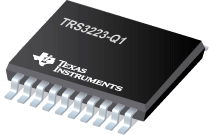

TRS3223-Q1是TI公司的一款无产品,TRS3223-Q1是具有 +/-15kV ESD 的汽车类 3V 至 5.5V 多通道 RS-232 线路驱动器/接收器,本页介绍了TRS3223-Q1的产品说明、应用、特性等,并给出了与TRS3223-Q1相关的TI元器件型号供参考。
TRS3223-Q1 - 具有 +/-15kV ESD 的汽车类 3V 至 5.5V 多通道 RS-232 线路驱动器/接收器 - 无 - RS-232收发器 - TI公司(Texas Instruments,德州仪器)
- Qualified for Automotive Applications
- RS-232 Bus-Pin ESD Protection Exceeds ±15 kV Using Human-Body Model (HBM)
- Meets or Exceeds the Requirements of TIA/EIA-232-F and ITU v.28 Standards
- Operates With 3-V to 5.5-V VCC Supply
- Operates up to 250 kbit/s
- Two Drivers and Two Receivers
- Low Standby Current . . . 1 µA Typical
- External Capacitors . . . 4 × 0.1 µF
- Accepts 5-V Logic Input With 3.3-V Supply
DESCRIPTION/ORDERING INFORMATION
The TRS3223 consists of two line drivers, two line receivers, and a dual charge-pump circuit with ±15-kV ESD protection pin to pin (serial-port connection pins, including GND). The device meets the requirements of TIA/EIA-232-F and provides the electrical interface between an asynchronous communication controller and the serial-port connector. The charge pump and four small external capacitors allow operation from a single 3-V to 5.5-V supply. The device operates at data signaling rates up to 250 kbit/s and a maximum of 30-V/µs driver output slew rate.
Flexible control options for power management are available when the serial port is inactive. The auto-powerdown feature functions when FORCEON is low and FORCEOFF is high. During this mode of operation, if the device does not sense a valid RS-232 signal, the driver outputs are disabled. If FORCEOFF is set low and EN is high, both drivers and receivers are shut off, and the supply current is reduced to 1 µA. Disconnecting the serial port or turning off the peripheral drivers causes auto-powerdown to occur. Auto-powerdown can be disabled when FORCEON and FORCEOFF are high. With auto-powerdown enabled, the device is activated automatically when a valid signal is applied to any receiver input. The INVALID output is used to notify the user if an RS-232 signal is present at any receiver input. INVALID is high (valid data) if any receiver input voltage is greater than 2.7 V or less than –2.7 V, or has been between –0.3 V and 0.3 V for less than 30 µs. INVALID is low (invalid data) if the receiver input voltage is between –0.3 V and 0.3 V for more than 30 µs. See Figure 4 for receiver input levels.







